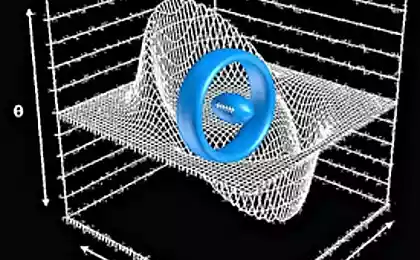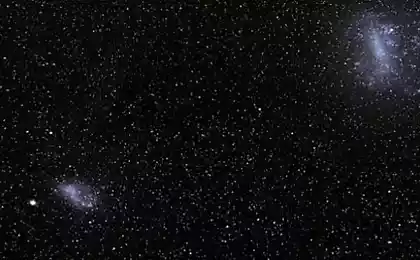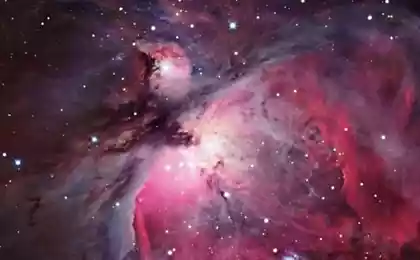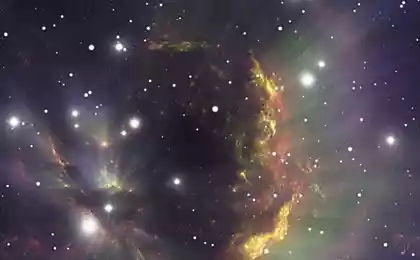CIBER experiment or story about how scientists found the second half of the Universe
Time Lapsoj photo missile launch CIBER, which started in 2013 with the launching pad Vallops, Virginia. It was the last of the 4 flights CIBER. Suborbital rockets are ideal for fast astronomical observations above the Earth's atmosphere. The photo notable works of the first three stages of missiles Black Brant XII. Rights Image: T. Arai / University of Tokyo. I> sup>
The discovery changes the scientists of galaxies - instead of the concept of limited-separated stellar seas, it may be that they should be considered as a single ocean, in which galaxies extend over much larger distances, are interconnected and form a single whole. I>
Experiment CIBER (Cosmic Infrared Background Experiment) can solve the problem of the origin of the background infrared radiation, which was discovered Space Telescope Spitzer. It is still unclear whether the source of its individual stars in intergalactic space, which are too far away to be seen directly, or first galaxies of the universe.
In 2007, researchers using data from an experiment BLAST (Balloon-borne Large Aperture Submillimeter Telescope) and the Space Telescope Spitzer, have suggested that for the cosmic background infrared radiation responsible gas-dust clouds surrounding young galaxies. And 70% of the radiation is in a galaxy located no closer than 9 billion light years from Earth. Active process of star formation going into them heats the intergalactic gas and dust to a temperature of about 30 K, which is the reason for the radiation.
latest work scholars on this subject, based on data from CIBER, suggests that for a significant portion of this radiation responsible individual, lonely wandering stars. Lead author of the study, published in the light of November 7 in the journal Science, Michael Zemcov (Michael Zemcov) notes:
We think that the stars are ejected into intergalactic space during the collision of galaxies. Recent data suggest that these emissions are caused by the tidal forces occur everywhere. Blockquote> Optical instruments CIBER. On top of the picture are two near infrared cameras, two are located below the spectrometer, in the lower right corner - Fraunhofer spectrometer. Photo: Jamie Bock / Caltech. I> sup>
Using a small unmanned suborbital rocket, ideal for short-term experiments such as CIBER, scientists got images of infrared radiation with two different wavelengths shorter than in previous experiments. Due to the fact that our atmosphere is also significant emission in this range, the measurement should be carried out of the atmosphere. During the flight, the rocket on a ballistic trajectory, the camera takes photos for 7 minutes, then sends the data to Earth, where scientists were filtered radiation from the bright stars, galaxies, and any other point sources, including the emission of the Milky Way. As a result, the researchers obtained distribution map fluctuations in the cosmic infrared background radiation, with separate nuclei that are larger than individual galaxies. The brightness of these fluctuations allows us to estimate the overall intensity of the background radiation.
input data processing scientists CIBER. In the transition to the second stage removes the noise from all the stars and galaxies. In the transition to the third, the radiation is "smeared out", so you could see the large-scale structure. The resulting smeared background does not come from any known star or galaxy. Researchers believe that it comes from stars that are in intergalactic space. Rights Image: NASA / JPL. I> sup>
To the surprise team of CIBER, map revealed a significant excess of light in intergalactic space, comparable to the emission of all galaxies together. This unexpected glow had more blue spectrum, which means that its brightness increased with decreasing wavelength. This suggests that the light comes from the individual, previously unrecorded, populations of stars located in intergalactic space, t. To. The emission spectrum of distant galaxies would have been much stronger shifted into the red region of the spectrum more.
Images taken experiment CIBER, cover large areas of space, representing the infrared radiation emanating from them, at different wavelengths (1.1 microns and 1.6 microns). It already processed photos that filtered noise from all known galaxies and applied smoothing algorithm, which exposes large-scale structure. Both photo shows the same pattern, proving the fact that the radiation came from the same sources. Rights Image: NASA / JPL-Caltech. I> sup>
Explained James Boca (James Bock), the principal investigator of the experiment CIBER:
The radiation is too bright and too biased to the blue side of the spectrum, so that it could be the source of the first generation of galaxies. The simplest and most logical assumption that best explains the measurements is that the source of this light are stars, separated from their galaxies, whose total radiation intensity exceeds the emission of all galaxies together. Blockquote> Future experiments will test this hypothesis. Meanwhile CIBER team is working on a more detailed analysis of the background infrared radiation to determine the question of how throughout the history of the universe is separated from its galaxy of stars.
Processed photograph shows a possible pattern of galaxies immersed in the unseen stellar halo. CIBER experiment results indicate that the total emission of these stars is comparable to the emission from all galaxies together. Rights Image: NASA / JPL-Caltech. I> sup>
Source: geektimes.ru/post/241134/























